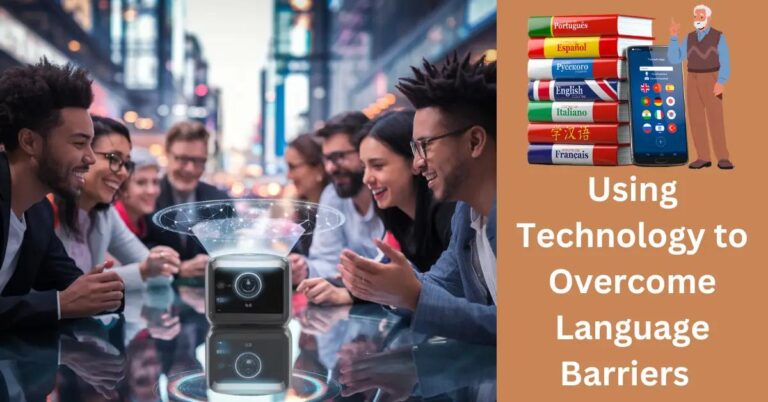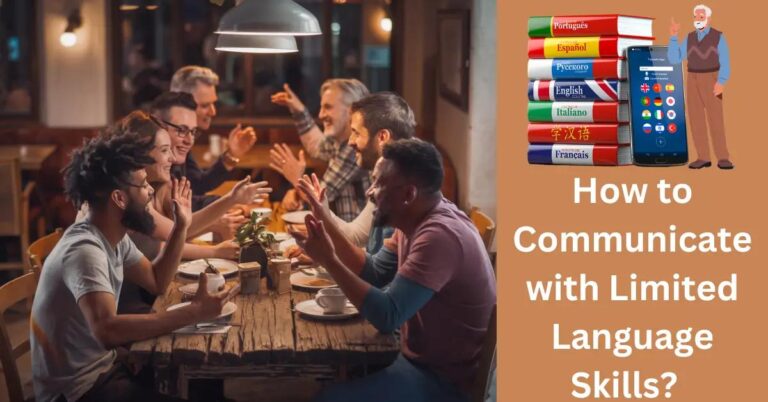TL;DR:
- Forming friendships across language barriers requires patience, empathy, and nonverbal communication.
- Use smiles, nods, and translation apps to bridge gaps.
- Translation apps have limitations; be mindful of cultural nuances.
- Nonverbal cues like gestures and facial expressions play a vital role.
- Engage in shared activities (sports, clubs) to foster bonds.
- Understanding cultural differences enriches communication.
- Language exchange, interactive apps, and cultural immersion enhance skills.
- Empathy and patience are key in dealing with language challenges.
- Technology aids learning, but personal connection remains crucial.
- Balance tech use with real-world interactions for meaningful relationships.
Have you ever tried making friends in a new country but couldn't speak the language? It might feel like a giant puzzle you can't solve, but don't worry. Forming bonds across language gaps is more doable than it seems. Patience and empathy are your best pals here. Use tools like translation apps, but also keep an eye on gestures. Let’s dive into unlocking the secrets of friendship without words.
Overcoming Language Differences to Form Friendships
Forming friendships with a language barrier can be tricky yet rewarding. It requires patience and empathy. Start with a big smile; it breaks barriers. When words fail, your smile says a lot. Kindness and understanding make people feel safe.
Translation apps can help bridge the gap when speaking gets tough. They can provide immediate help, but remember they have limits. The apps might not capture cultural meanings or nuances. Misunderstandings can still happen, so use them wisely.
When speaking is hard, rely on nonverbal cues. Body language is a strong tool. Watch gestures and facial expressions to understand feelings. For example, nodding means "yes" in most places. Mimic gestures that show positive feelings. This encourages trust and brings people closer.
Cultural differences play a big role in communication. Learn about the friend's culture because it helps in understanding them better. Each culture has its unique way of expressing joy, anger, or even confusion. Respecting these differences makes interactions positive and builds harmony.
Common activities can connect people beyond language. Try things like playing sports together. Choose activities that both enjoy, like hiking or cooking. Shared experiences build bonds stronger than words sometimes can. Join clubs in your neighborhood or take classes that interest both of you.
Creating new friendships without a shared language might feel challenging, but it's not impossible. Remember that sharing moments, understanding silent cues, and enjoying activities together forms strong connections. By committing to patience and empathy, anyone can bridge the language divide and create wonderful friendships.
Connecting Beyond Words: Nonverbal Communication
How do you get around language barriers? Nonverbal communication can bridge gaps when words fail. Understanding gestures and body language helps convey your thoughts. Use your hands to clarify or emphasize your message. Smiles and nods can show agreement and encourage others to feel at ease.
Reading and interpreting body language across cultures requires curiosity. Different cultures may recognize different signals. In one culture, eye contact might show honesty, but in another, it might seem rude. Learn those differences to avoid misunderstandings. Be open-minded and pay attention to how others react to your gestures.
Using gestures and facial expressions effectively means being clear but gentle. Overly firm expressions might scare or confuse someone. Maintain a friendly demeanor to communicate warmth and approachability. Your expressions speak before your words do; they set the tone for interaction.
How to make friends despite language barriers? Convey warmth with nonverbal signals like touch. A warm handshake or pat on the back is universal. Sitting open (arms uncrossed) shows you are ready to connect and listen. These simple acts can make others feel welcomed and valued.
Leveraging visual aids or drawings helps when words run dry. Sketching a quick image can replace the need for complex language. Sometimes, a picture is worth a thousand words. It simplifies the exchange and creates a shared understanding of ideas.
Practicing active listening through nonverbal signals involves nodding or tilting your head slightly. This shows you are engaged and interested. Listening isn’t just about hearing; it’s also about demonstrating attention. Nonverbal cues tell the other person you are present in the conversation.
Connecting beyond words involves using these tools with patience and empathy. Everyone appreciates genuine efforts to understand and connect. For more on navigating language challenges, explore resources like tips on nonverbal communication.
Multilingual Socializing: Breaking the Ice and Building Friendships
When I moved to a new country, making friends at school seemed challenging. But, I soon realized the key lay in approaching social gatherings with an open mind. An open mind invites new experiences. It helps when interacting in a new place.
One way I found effective was to initiate conversations using friendly phrases. Simple greetings or compliments often work wonders in breaking the ice. These small phrases can open the door to deeper connections. For example, saying, "Hi, I like your backpack," is universal.
Participating in social activities like sports or joining classes can also foster new friendships. Such activities are powerful because they create shared experiences. Shared experiences build strong bonds quickly. Also, being part of these groups encourages natural interaction, often without a need for many words.
Another helpful tip is to join clubs or groups that align with your personal interests. When you share activities like art, cooking, or chess, the language barrier often fades. You focus more on what you like, not on what you wish you could say. Finding these common interests is vital in making connections.
Creating language-inclusive spaces is another important aspect. Such spaces invite students from different backgrounds to interact comfortably. Schools can allocate areas where multilingual signs or simple language charts appear. They promote interactions that speak beyond words.
Making international friends isn't just about language; it's about connection. It’s okay if I didn’t understand everything at first. Smiling or using hand gestures helped me show that I wanted to be friends. After a while, the language became easier to understand because I was putting myself in new situations.
So, if you’re wondering how to make friends despite language barriers in school, remember these steps. Start each interaction with openness and empathy, and you’ll find yourself making friends who appreciate effort over perfection.
Enhancing Language Skills for Meaningful Connections
Moving to a country without speaking the local language is a unique challenge. To thrive, embrace language exchange partners as your first step. These partners want to learn your language while you learn theirs. This mutual learning leads to deeper connections and lasting friendships.
By leveraging digital tools, you can enhance your language skills faster. Use language apps that offer interactive lessons and real-life practice scenarios. These resources help with pronunciation and everyday conversations, making it easier to connect with others.
Cultural exchange programs provide another avenue for friendships. These programs immerse you in a new culture and language. You live with local families and participate in their daily lives, which fosters both understanding and language skills.
Setting clear, achievable language learning goals keeps you motivated. Start with simple phrases used in daily interactions. As your skills grow, focus on complex conversations. This progress fuels your confidence and eases integration into the community.
Immersive language practice opportunities exist everywhere if you seek them. Visit local markets, cafes, or join clubs where locals gather. These experiences not only improve your language skills but also provide cultural insights.
Remember, meaningful connections require effort and patience. Celebrate small victories in your learning journey. Each new word or phrase is a step closer to deeper friendships. Embrace each chance to practice and learn, as every effort brings you closer to understanding and being understood.
Bridging Communication Barriers with Technology and Empathy
Dealing with someone who faces language barriers can be challenging, but technology and empathy can help bridge the gap. To interact smoothly, I suggest using translation apps. These apps can provide quick translations and are often easy to use. However, they might not always be accurate, so they should be a stepping stone rather than a crutch.
Digital tools are helpful for virtual exchanges and practice. Video calls or chat apps offer platforms where you can practice your language skills with others. These interactions enhance learning and help you understand cultural nuances better.
Empathy plays a crucial role in language learning. Building empathy involves putting yourself in the shoes of someone learning a new language. Think of how daunting it can be to express yourself with limited vocabulary. Showing patience and recognizing small achievements can foster a supportive environment. Understanding comes with patience; everyone’s language journey is unique.
Practicing patience is key when communicating across cultures. Everyone speaks differently, and adapting to new accents and expressions takes time. During conversations, I listen attentively and confirm understanding by paraphrasing what I heard. This practice prevents misunderstandings and shows respect for the speaker.
While technology plays a crucial role, maintaining personal connections is vital. Too much reliance on tech might make interactions impersonal. Instead, I advocate for a balance. Use technology to get past initial barriers, but focus on building real connections. Share experiences and learn about each other's cultures beyond words.
Embracing both empathy and technology enriches communication. Patience, empathy, and the right tools together build bridges over language gaps, forming meaningful friendships along the way. After all, genuine connections speak louder than words.
Conclusion
To form friendships across language barriers, patience and empathy are key. Translation apps help, but nonverbal cues often say more. Understand cultural differences and find shared activities to bridge gaps. Use body language wisely, and look for ways to connect through common interests. Improving language skills with partners or through cultural programs can expand your connection network. Technology can assist, but personal interaction matters most. By blending these strategies, you can overcome language challenges and form deep, rewarding bonds in your new home.







